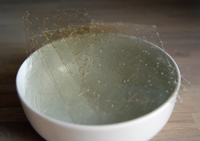
Photo from wikipedia
Microcapsules and microgels consisting of macromolecular networks have received increasing attention due to their biomedical and pharmaceutical applications. Protein microgels and in particular silk-based microcapsules have desirable properties due to… Click to show full abstract
Microcapsules and microgels consisting of macromolecular networks have received increasing attention due to their biomedical and pharmaceutical applications. Protein microgels and in particular silk-based microcapsules have desirable properties due to their biocompatibility and lack of toxicity. Typically such structures formed through emulsion templating are spherical in geometry due to interfacial tension. However, approaches to synthesis particles with more complex and non-spherical geometries are sought due to their packing properties and cargo release characteristics. Here, we describe a droplet-microfluidic strategy for generating asymmetric tubular-like microgels from reconstituted silk fibroin; a major component of native silk. It was determined using fluorescence microscopy, that the shear stress within the microchannel promotes surface protein aggregation, resulting in the asymmetric morphology of the microgels. Moreover, the structural transition that the protein undergoes was confirmed using FTIR. Crucially, the core of the microgels remains liquid, while the surface has fully aggregated into a fibrillar network. Additionally, we show that microgel morphology could be controlled by varying the dispersed to continuous phase flow rates, while it was determined that the radius of curvature of the asymmetric microgels is correlated to the wall shear stress. By comparing the surface fluorescence intensity of the microgels as a function of radius of curvature, the effect of the shear stress on the amount of aggregation could be quantified. Finally, the potential use of these asymmetric microgels as carriers of cargo molecules is showcased. As the core of the microgel remains liquid but the shell has gelled, this approach is highly suitable for the storage of bio-active cargo molecules such as antibodies, making such a delivery system attractive in the context of biomedical and pharmaceutical applications.
Journal Title: Scientific Reports
Year Published: 2021
Link to full text (if available)
Share on Social Media: Sign Up to like & get
recommendations!